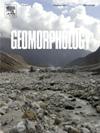东昆仑山北侧河流阶地记录的构造隆升
IF 3.1
2区 地球科学
Q2 GEOGRAPHY, PHYSICAL
引用次数: 0
摘要
东昆仑山为青藏高原东北部的高原生长提供了重要的见解。然而,在过去的几百万年里,这个地区的隆起历史仍然知之甚少。为了解决这一问题,我们将宇宙核素埋藏测年和钾长石pIRIR测年与地貌指数和山谷形态分析相结合,重建了格尔木河和开木其河的第四纪隆升和沉积历史。结果表明,格尔木河沉积物在1.41 Ma之前开始积聚,其高程与现在的格尔木河床相似或低于现在的格尔木河床,表明格尔木河在这一时期达到了现在的水位。1.41 Ma以来的沉积物充填和下切循环主要受气候变化驱动,基岩未出现切口。侵蚀速率(20-83 mm/ka)、河道陡度指数、峡谷宽度和谷底宽高比一致表明,在过去的几百万年里,该地区几乎没有构造隆升。这些发现证实了北昆仑断裂自第四纪以来的不活动,并强调了长期干旱化和幕式润湿事件在塑造该地区地貌演化中的主导作用。该研究为构造稳定性与气候之间的相互作用提供了重要的见解,促进了我们对青藏高原构造稳定地区景观演化的理解。本文章由计算机程序翻译,如有差异,请以英文原文为准。
Tectonic uplift recorded by the river terraces in the northern flank of East Kunlun Shan
The East Kunlun Shan offers key insights into plateau growth on the northeastern Tibetan Plateau. However, the uplift history of this region over the past several million years remains poorly understood. To address this, we combined cosmogenic nuclide burial dating and K-feldspar pIRIR dating with geomorphic indices and valley morphology analyses to reconstruct the Quaternary uplift and sedimentary history along the Golmud and Kaimuqi Rivers. Our results show that river sediments began accumulating before 1.41 Ma, and their elevation, similar to or lower than the present Golmud River bed, indicates that the river reached its current level by this time. Cycles of sediment fill and downcutting since 1.41 Ma were primarily driven by climatic changes, as no bedrock incision was observed. Erosion rates (20–83 mm/ka), channel steepness indices, valley width, and valley floor width-valley height ratios consistently suggest minimal or no tectonic uplift over the past several million years. These findings confirm the inactivity of the North Kunlun Fault since the Quaternary and highlight the dominant role of long-term aridification and episodic wetting events in shaping the region's geomorphic evolution. This study provides crucial insights into the interplay between tectonic stability and climate, advancing our understanding of landscape evolution in tectonically stable regions of the Tibetan Plateau.
求助全文
通过发布文献求助,成功后即可免费获取论文全文。
去求助
来源期刊

Geomorphology
地学-地球科学综合
CiteScore
8.00
自引率
10.30%
发文量
309
审稿时长
3.4 months
期刊介绍:
Our journal''s scope includes geomorphic themes of: tectonics and regional structure; glacial processes and landforms; fluvial sequences, Quaternary environmental change and dating; fluvial processes and landforms; mass movement, slopes and periglacial processes; hillslopes and soil erosion; weathering, karst and soils; aeolian processes and landforms, coastal dunes and arid environments; coastal and marine processes, estuaries and lakes; modelling, theoretical and quantitative geomorphology; DEM, GIS and remote sensing methods and applications; hazards, applied and planetary geomorphology; and volcanics.
 求助内容:
求助内容: 应助结果提醒方式:
应助结果提醒方式:


